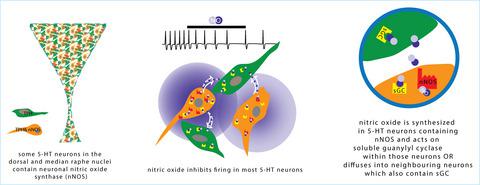当前位置:
X-MOL 学术
›
Eur. J. Neurosci.
›
论文详情
Our official English website, www.x-mol.net, welcomes your
feedback! (Note: you will need to create a separate account there.)
A role for nitric oxide in serotonin neurons of the midbrain raphe nuclei
European Journal of Neuroscience ( IF 2.7 ) Pub Date : 2020-03-13 , DOI: 10.1111/ejn.14713 Sarah E. Gartside 1 , Abdurrahman Ercan Yurttaser 1 , Amy L. Burns 1 , Nebojša Jovanović 1 , Katie J. Smith 1 , Nana Shika Amegashiti 1 , Bas M. J. Olthof 1
European Journal of Neuroscience ( IF 2.7 ) Pub Date : 2020-03-13 , DOI: 10.1111/ejn.14713 Sarah E. Gartside 1 , Abdurrahman Ercan Yurttaser 1 , Amy L. Burns 1 , Nebojša Jovanović 1 , Katie J. Smith 1 , Nana Shika Amegashiti 1 , Bas M. J. Olthof 1
Affiliation

|
Neuronal nitric oxide synthase (nNOS) catalyses the production of the neurotransmitter nitric oxide. nNOS is expressed in the dorsal raphe nucleus (DRN), a source of ascending serotonergic projections. In this study, we examined the distribution nNOS and the function of nitric oxide in the DRN and adjacent median raphe nucleus (MRN) of the rat. We hypothesized that nNOS is differentially expressed across the raphe nuclei and that nitric oxide influences the firing activity of a subgroup of 5‐HT neurons. Immunohistochemistry revealed that, nNOS is present in around 40% of 5‐HT neurons, throughout the DRN and MRN, as well as in some non‐5‐HT neurons immediately adjacent to the DRN and MRN. The nitric oxide receptor, soluble guanylyl cyclase, was present in all 5‐HT neurons examined in the DRN and MRN. In vitro extracellular electrophysiology revealed that application of the nitric oxide donor, diethylamine NONOate (30–300 µM) inhibited 60%–70% of putative 5‐HT neurons, excited approximately 10% of putative 5‐HT neurons and had no effect on the rest. The inhibitory response to nitric oxide was blocked by [1H‐[1,2,4]oxadiazolo‐[4, 3‐a]quinoxalin‐1‐one (ODQ, 30 or 100 µM), indicating mediation by soluble guanylyl cyclase. Juxtacellular labelling revealed that nitric oxide inhibits firing in both putative 5‐HT neurons which express nNOS and those which do not express nNOS. Our data are consistent with the notion that nitric oxide acts as both a trans‐synaptic and autocrine signaller in 5‐HT neurons in the DRN and MRN and that its effects are widespread and primarily inhibitory.
中文翻译:

一氧化氮在中脑沟phe核素5-羟色胺神经元中的作用
神经元一氧化氮合酶(nNOS)催化神经递质一氧化氮的产生。nNOS在背沟核(DRN)中表达,DRN是上升的血清素能投射的来源。在这项研究中,我们检查了大鼠的DRN和邻近的中缝核(MRN)中nNOS的分布和一氧化氮的功能。我们假设nNOS在整个裂隙核中差异表达,并且一氧化氮影响5-HT神经元亚组的激发活性。免疫组织化学显示,在整个DRN和MRN中,大约40%的5-HT神经元中以及与DRN和MRN紧邻的一些非5-HT神经元中都存在nNOS。一氧化氮受体,可溶性鸟苷酸环化酶,存在于DRN和MRN中检查的所有5-HT神经元中。体外细胞外电生理学研究表明,一氧化氮供体一氧化二氮胺(30–300 µM)的应用抑制了60%–70%的5-HT神经元,激发了约10%的5-HT神经元,对神经元没有影响。休息。对一氧化氮的抑制反应被[1H- [1,2,4]恶二唑-[4,3-a]喹喔啉-1-酮(ODQ,30或100 µM)阻断,表明其被可溶性鸟苷环化酶介导。并列细胞标记显示一氧化氮抑制表达nNOS和不表达nNOS的5-HT神经元的放电。我们的数据与一氧化氮在DRN和MRN中的5-HT神经元中同时充当跨突触和自分泌信号转导的观点是一致的,并且其作用广泛且主要是抑制性的。二乙胺NONOate(30–300 µM)抑制了60%–70%的5-HT神经元,激发了大约10%的5-HT神经元,对其余神经元无影响。对一氧化氮的抑制反应被[1H- [1,2,4]恶二唑-[4,3-a]喹喔啉-1-酮(ODQ,30或100 µM)阻断,表明由可溶性鸟苷环化酶介导。并列细胞标记显示一氧化氮抑制表达nNOS和不表达nNOS的5-HT神经元的放电。我们的数据与一氧化氮在DRN和MRN中的5-HT神经元中同时充当跨突触和自分泌信号转导的观点是一致的,并且其作用广泛且主要是抑制性的。二乙胺NONOate(30–300 µM)抑制了60%–70%的5-HT神经元,激发了大约10%的5-HT神经元,对其余神经元无影响。对一氧化氮的抑制反应被[1H- [1,2,4]恶二唑-[4,3-a]喹喔啉-1-酮(ODQ,30或100 µM)阻断,表明由可溶性鸟苷环化酶介导。并列细胞标记显示一氧化氮抑制表达nNOS和不表达nNOS的5-HT神经元的放电。我们的数据与一氧化氮在DRN和MRN中的5-HT神经元中同时充当跨突触和自分泌信号转导的观点是一致的,并且其作用广泛且主要是抑制性的。对一氧化氮的抑制反应被[1H- [1,2,4]恶二唑-[4,3-a]喹喔啉-1-酮(ODQ,30或100 µM)阻断,表明由可溶性鸟苷环化酶介导。并列细胞标记显示一氧化氮抑制表达nNOS和不表达nNOS的5-HT神经元的放电。我们的数据与一氧化氮在DRN和MRN中的5-HT神经元中同时充当跨突触和自分泌信号转导的观点是一致的,并且其作用广泛且主要是抑制性的。对一氧化氮的抑制反应被[1H- [1,2,4]恶二唑-[4,3-a]喹喔啉-1-酮(ODQ,30或100 µM)阻断,表明由可溶性鸟苷环化酶介导。并列细胞标记显示一氧化氮抑制表达nNOS和不表达nNOS的5-HT神经元的放电。我们的数据与一氧化氮在DRN和MRN中的5-HT神经元中同时充当跨突触和自分泌信号转导的观点是一致的,并且其作用广泛且主要是抑制性的。
更新日期:2020-03-13
中文翻译:

一氧化氮在中脑沟phe核素5-羟色胺神经元中的作用
神经元一氧化氮合酶(nNOS)催化神经递质一氧化氮的产生。nNOS在背沟核(DRN)中表达,DRN是上升的血清素能投射的来源。在这项研究中,我们检查了大鼠的DRN和邻近的中缝核(MRN)中nNOS的分布和一氧化氮的功能。我们假设nNOS在整个裂隙核中差异表达,并且一氧化氮影响5-HT神经元亚组的激发活性。免疫组织化学显示,在整个DRN和MRN中,大约40%的5-HT神经元中以及与DRN和MRN紧邻的一些非5-HT神经元中都存在nNOS。一氧化氮受体,可溶性鸟苷酸环化酶,存在于DRN和MRN中检查的所有5-HT神经元中。体外细胞外电生理学研究表明,一氧化氮供体一氧化二氮胺(30–300 µM)的应用抑制了60%–70%的5-HT神经元,激发了约10%的5-HT神经元,对神经元没有影响。休息。对一氧化氮的抑制反应被[1H- [1,2,4]恶二唑-[4,3-a]喹喔啉-1-酮(ODQ,30或100 µM)阻断,表明其被可溶性鸟苷环化酶介导。并列细胞标记显示一氧化氮抑制表达nNOS和不表达nNOS的5-HT神经元的放电。我们的数据与一氧化氮在DRN和MRN中的5-HT神经元中同时充当跨突触和自分泌信号转导的观点是一致的,并且其作用广泛且主要是抑制性的。二乙胺NONOate(30–300 µM)抑制了60%–70%的5-HT神经元,激发了大约10%的5-HT神经元,对其余神经元无影响。对一氧化氮的抑制反应被[1H- [1,2,4]恶二唑-[4,3-a]喹喔啉-1-酮(ODQ,30或100 µM)阻断,表明由可溶性鸟苷环化酶介导。并列细胞标记显示一氧化氮抑制表达nNOS和不表达nNOS的5-HT神经元的放电。我们的数据与一氧化氮在DRN和MRN中的5-HT神经元中同时充当跨突触和自分泌信号转导的观点是一致的,并且其作用广泛且主要是抑制性的。二乙胺NONOate(30–300 µM)抑制了60%–70%的5-HT神经元,激发了大约10%的5-HT神经元,对其余神经元无影响。对一氧化氮的抑制反应被[1H- [1,2,4]恶二唑-[4,3-a]喹喔啉-1-酮(ODQ,30或100 µM)阻断,表明由可溶性鸟苷环化酶介导。并列细胞标记显示一氧化氮抑制表达nNOS和不表达nNOS的5-HT神经元的放电。我们的数据与一氧化氮在DRN和MRN中的5-HT神经元中同时充当跨突触和自分泌信号转导的观点是一致的,并且其作用广泛且主要是抑制性的。对一氧化氮的抑制反应被[1H- [1,2,4]恶二唑-[4,3-a]喹喔啉-1-酮(ODQ,30或100 µM)阻断,表明由可溶性鸟苷环化酶介导。并列细胞标记显示一氧化氮抑制表达nNOS和不表达nNOS的5-HT神经元的放电。我们的数据与一氧化氮在DRN和MRN中的5-HT神经元中同时充当跨突触和自分泌信号转导的观点是一致的,并且其作用广泛且主要是抑制性的。对一氧化氮的抑制反应被[1H- [1,2,4]恶二唑-[4,3-a]喹喔啉-1-酮(ODQ,30或100 µM)阻断,表明由可溶性鸟苷环化酶介导。并列细胞标记显示一氧化氮抑制表达nNOS和不表达nNOS的5-HT神经元的放电。我们的数据与一氧化氮在DRN和MRN中的5-HT神经元中同时充当跨突触和自分泌信号转导的观点是一致的,并且其作用广泛且主要是抑制性的。































 京公网安备 11010802027423号
京公网安备 11010802027423号